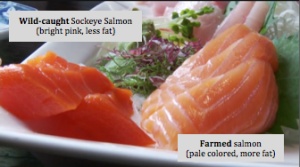The following content was provided by Registered Dietitian, Jaime Windrow.
When I first start working with a new athlete, I will usually review some food logs to see how things are progressing. You know what I see? Chicken. And lots of it! Chicken and broccoli. Chicken on a salad. Chicken on a low carb wrap. While a skinless, free-range chicken breast is a great source of lean protein, my fear is that food boredom is right around the corner. Well now is the perfect time of year to branch out!
Stop into your local fish store and you’ll notice that the once dull and pale shade of peach salmon is now a shiny, vibrant red color. It is now “in-season” for wild Alaskan salmon, so be sure to spend the extra few bucks on the real deal, your taste buds will thank you. And to be honest, this is usually the cheapest time of year to buy wild anyway!
And since we are on the topic, here are some thoughts on salmon in general. And check out someCore Diet salmon recipesbelow!
General Salmon Recommendations:
- Best Choice: Wild Alaskan Coho Salmon FAS (frozen at sea)
- Second Best Choice: Wild Alaskan King Salmon Fresh
- Limit (or Avoid) Consumption: Farmed Atlantic Salmon*
*Note: "Fresh Atlantic Salmon" is generally farmed raised as the name “Atlantic” refers to the species (NOT the origin). The Environmental Defense Fund has issued a health advisory for farmed Altantic salmon due to high levels of PCBs. If you cannot find wild, look for clearly labeled U.S. farmed freshwater coho salmon.
Types of Wild Alaskan Salmon:
Red (Sockeye):has a richer and more intense flavor and color. Its red color is enhanced due to it eating krill, and requires fresh water to grow (salmon run). It actually spends over a year in the fresh water! Red Sockeye is more expensive because it's less abundant.
Pink (Humpback):has a mild flavor and is lighter in color. Upon hatching, the Humpback goes directly into the sea where it is caught. It's actually pink when caught from the sea, however both red and pink do lose a little coloration in the canning process. Pink salmon is definitely less expensive as it is more abundant.
"I’m getting so bored with canned tuna. What about canned salmon?"
Canned tuna seems to be a staple in many households, but I very rarely see salmon. This is quick and easy as it is shelf stable and fully cooked. There is no thawing or special preparation. And with little to no mercury content, it’s a great way to get those omega-3s in. When fresh wild Alaskan salmon is not in season, this is a great alternative.
Canned Salmon Recommendations:
First, make sure it is WILD ALASKAN. I very rarely see canned salmon that is not, but always double check the label to make sure. You’ll have 2 choices when it comes to canned salmon – red or pink – pick a color! Nutritionally, they are pretty close, but red salmon has slightly higher fat, vitamin A & D.
Whether you choose red or pink you are still making a good choice as long as it's Wild Alaskan. If it's not, then it's probably farmed and I would definitely look for a brand that is wild. If you are not sure about what color to choose – do a blind taste test! Buy one of each and see which one you prefer. Although red is known to have a superior taste, some people cannot taste the difference between the two.
What do I do? I purchase both. I’ll use pink if I am using recipes with lots of ingredients such as herbs and mustards, and I’ll save the red for when I am using minimal ingredients, such as lemon juice or vinegar. If you find that it is just too fishy for you, try one of these simple, fast tips:
- Adding some fresh squeezed lemon to it first (cuts the fishiness)
- Mix it up with Dijon mustard and onions
- Mix it up with vinegar and onions
Try one of these Core Diet salmon recipes:
~ Jaime
*Salmon comparison photo by www.nofarmedsalmon.com















Comments